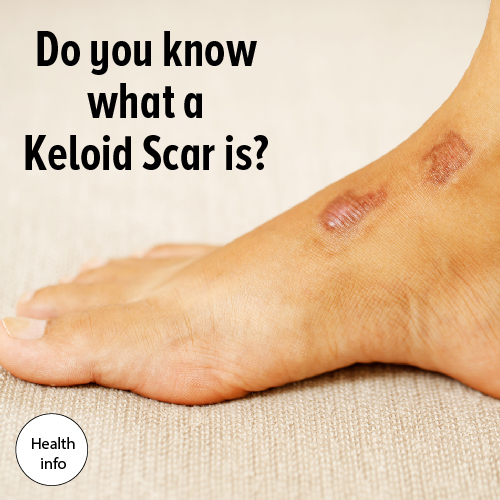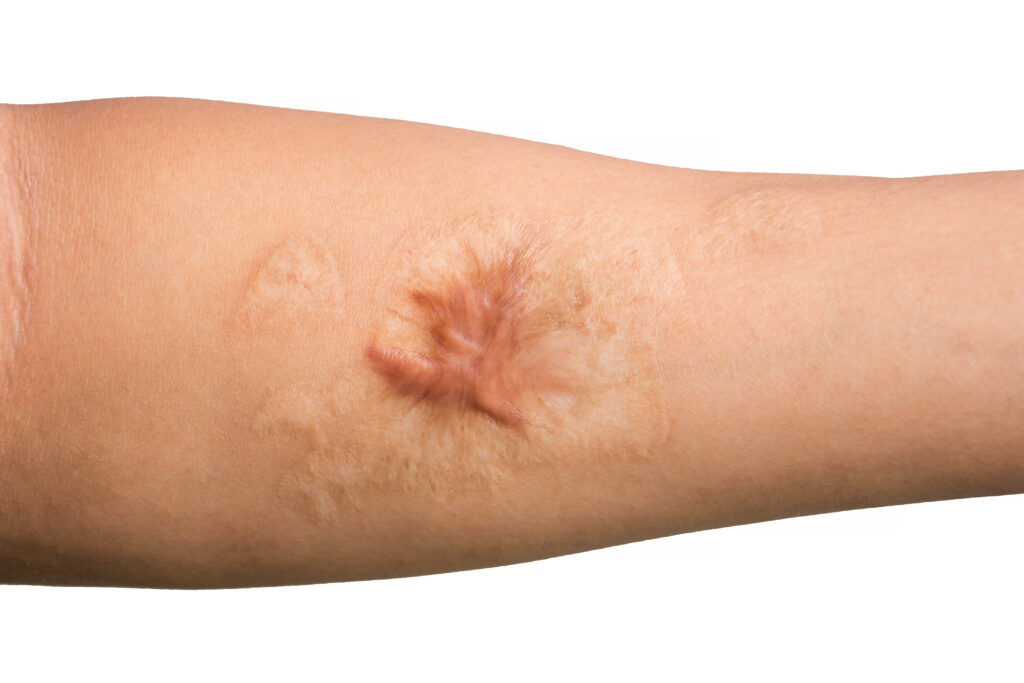- Home
- Health Center
- Health Info
- Do You Know What a Keloid Scar is?
Skin Care
Do You Know What a Keloid Scar is?


When a wound heals, it leaves a scar. A keloid scar is one that becomes thick, lumpy, raised and larger than the original wound. A keloid, or keloid scar, is a kind of overgrown scar, or an overly aggressive healing response to a wound.
They can develop after very minor skin damage and spread beyond the original area of skin damage.
What Do Keloid Scars Look Like?
Generally, a keloid scar is an enlarged, raised scar that can be pink, red, skin-coloured or darker than the surrounding skin.
You may have a keloid scar if you notice the following:
- It appears gradually. It can take as long as 3 to 12 months or even longer before you notice a keloid beginning to develop; most tend to appear within a year of the original skin damage.
- Your scar is easily irritated. It may become irritated from friction, such as rubbing against clothing.
- It gradually turns darker. A keloid typically begins as a pink, red, or flesh-colored scar that darkens over time and ends up looking darker than the skin around the scar.
How to Manage a Keloid Scar?
Keloid scars, which are typically thick and irregular, rarely go away on their own. They can be challenging to treat, which is why we emphasize the importance of preventing keloids from forming in the first place.
What can you do to prevent it? Make use of these preventive self-care tips !
Prevention:
- Practice good wound care
Keep a wound clean and moist. Applying a thin layer of petrolatum jelly would help too.
- Protect your skin from injury
Try to avoid injuring your skin. Consider not getting body piercings, tattoos and elective surgeries. Even minor injuries — such as ingrown hairs, cuts and scratches — can incite a keloid to grow.
Treatment:
- Silicon Therapy
– Gold standard in scar management & first-line non-invasive treatment option for hypertrophic scars & minor keloids.
– Silicone gel has been shown to have the ability to hasten hypertrophic scar maturation & decrease associated symptoms of pain, rigidity & itchiness.
Other treatment options include Ligature, Cryotherapy, Laser therapy, etc which is done by Healthcare professionals – Dermatologist.
In Conclusion
There is no one treatment that works best for all keloids. Healthcare providers typically tailor the treatment to the individual based upon factors such as age and type of keloid. Keloids are difficult to banish completely, and using more than one type of treatment often improves results.
Therefore, Do not hesitate to visit your nearest Caring and speak to us as we will do our best to help you solve your concern.
References:
- Keloids and hypertrophic scars: pathophysiology, classification and treatment. Berman B, Maderal A, Raphael B. Dermatol Surg. 2017 Jan;43(Suppl 1):S3-S18.
- Management of keloid and hypertrophic scars. Ann Burns Fire Disasters. Edriss AS, Mestak J. (Web assessed in August 2022). Web link: https://www.ncbi.nlm.nih.gov/pmc/articles/PMC3187998/
- Keloid Scar. Mayo Clinic. (Web assessed in August 2022). Web link: https://www.mayoclinic.org/diseases-conditions/keloid-scar/symptoms-causes/syc-20520901
- Keloid and Hypertrophic Scar. MIMS Dermatology. (Web assessed in August 2022). Web link: https://specialty.mims.com/keloids%20and%20hypertrophic%20scars/references?channel=dermatology.
Latest Health Info
Healthy Weight, Happy Joints
How Does Weight Affect Knee Health? The Link Between Pounds And Pain Osteoarthritis (OA) involves the degeneration of joints, which ...
The Gut Warriors: Prebiotics, Probiotics and Postbiotics
When it comes to gut health, you’ve probably heard of prebiotics and probiotics. But did you know there’s also ...
Tip Moreh: Masa Berbuka Puasa
Moreh adalah tradisi unik yang biasanya diadakan selepas solat tarawih pada bulan Ramadan. Ia melibatkan penyediaan dan perkongsian makanan ringan ...



